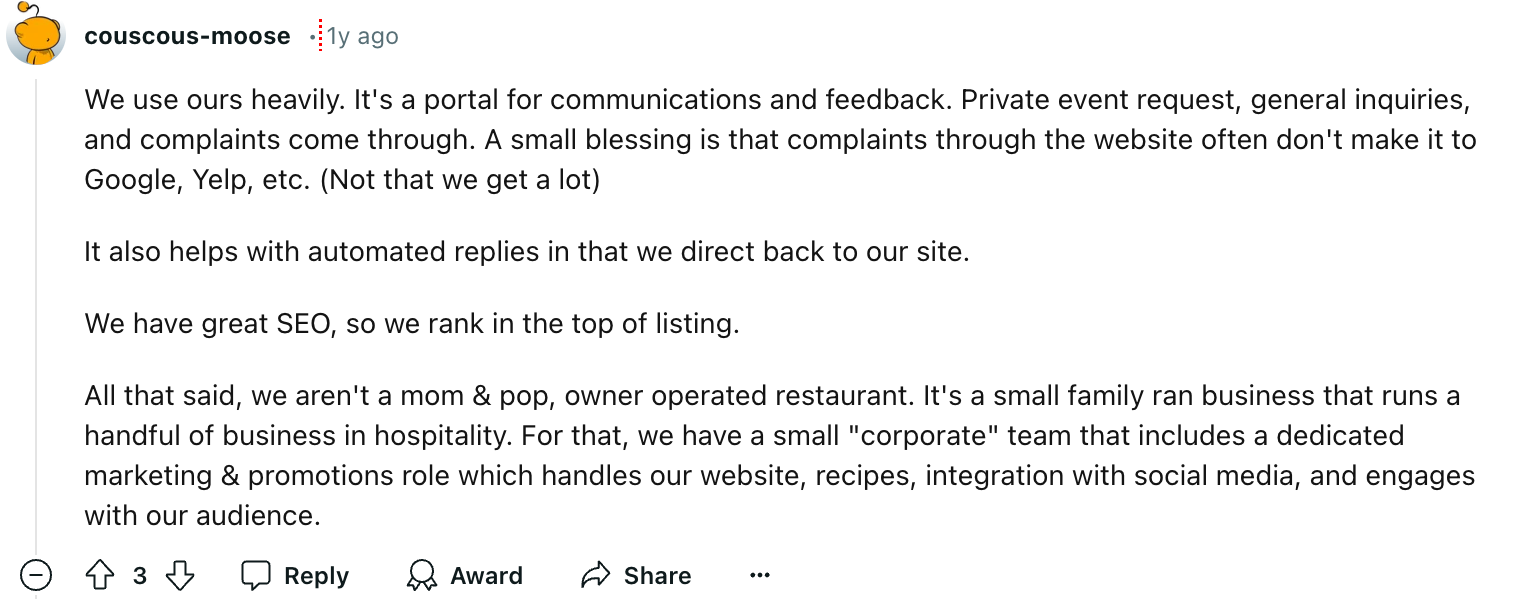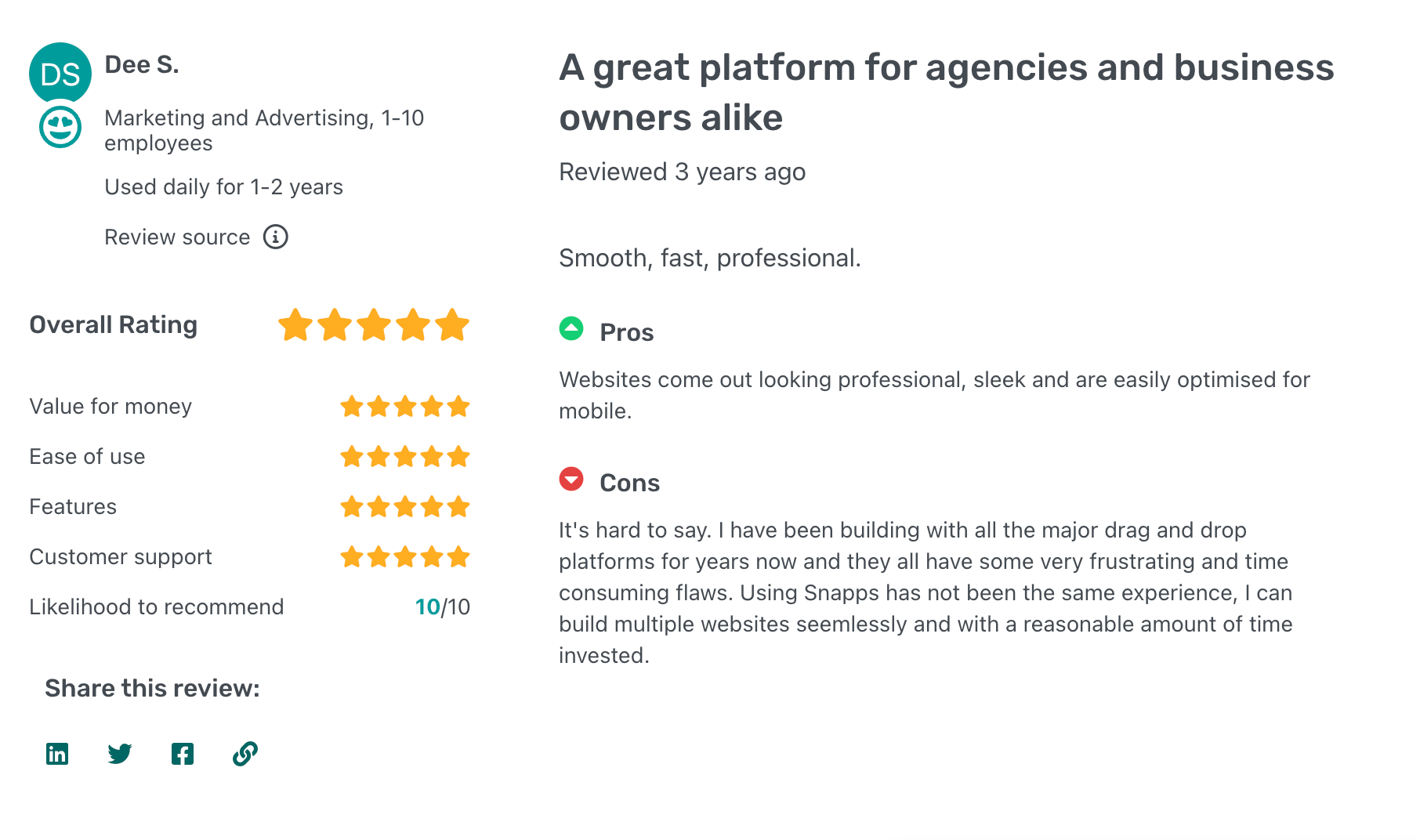According to Eric from My First Website YouTube Vlog, website builders are a superb choice for food blogging beginners. Their affordability, user-friendly interfaces, customizable templates, and free SSL and domain options make them accessible.
Snapps courses are now available
The best website builders for food blogs are:
- Snapps.ai
- WordPress.org
- Wix
- Shopify
- Squarespace
- Hostinger
- Mobirise
Creating a website ensures your blog captivates diners with appealing and functional sites. Redditors say that websites attract customers through easier navigation and also allow for menu browsing, table reservations, and even online orders, all from a single platform. Almost one-third of small businesses do not have a website, which shows the benefit of having an online presence in terms of competition.


Website builders can help you create a professional food blog. There are platforms that provide customizable templates and features tailored to food blogging. These tools offer a user-friendly interface, making it simple to share tasty recipes, integrate social media, and engage with readers through comments and shares.

Using a website builder for a food blog comes with many advantages. Engaging customers with online menus, reservations, and ordering options can boost customer interaction. A Redditor says that it highlights your brand’s identity and extends your marketing reach with built-in tools.

Building a website with a builder is faster than doing it from scratch. Ready-to-use templates and drag-and-drop editors shorten the setup time to have a functional site in hours rather than weeks.


In this article, we will explore seven website builders to create a food blog. You'll find everything you need to get started online.
1. Snapps.ai: Innovative AI-Powered Website Builder
Snapps.ai stands out as an AI-powered website builder designed to create stunning websites efficiently. Snapps.ai has a customer satisfaction rate of 92%, trusted by over 100 companies, it is a versatile platform for food blogs.
The platform comes with different features for your food blog. One unique feature is its Snapps Graphics that design images, logos, and graphics. It is perfect for creating attractive visuals for recipes and other food-related content. Other features on Snapps.ai are:
- 9 Food-Specific Templates: Choose from nine templates for food blogs and recipe sharing.
- Snappseo and more SEO tools: Built-in tools for SEO analysis and improvement, ensuring blogs rank higher in search results.
- Drag-and-Drop Widgets: An editor that designs your site with no coding knowledge.
- Snapps AI Image: Create visuals for blog posts, recipes, and social media with AI-powered image generation.
- Mobile Responsiveness: Ensures that blogs look great on smartphones to tablets.

Reviews from Snapps.ai all over the internet shared how this platform helps their small businesses, but it is also important to note its pros and cons. For instance:
| Pros | Cons |
|---|---|
| Extensive library of templates suitable for food blogs | Some users might find the many features overwhelming at first. |
| AI tools for image generation and content creation streamline the process. | Advanced customization may need a learning curve for newcomers. |
| SEO and social media tools to boost online visibility. |
If you’re on a budget, Snapps.ai comes with the perfect pricing plans for food enthusiasts below:
| Plan | Sites Published | Cost |
|---|---|---|
| Beta Pack | Pay per site | $8.08/mo |
| Starter Pack | Up to 5 sites | $66.25/mo |
| Decade Pack | Up to 10 sites | $132.50/mo |
| Agency Lite Pack | Up to 25 sites | $289.58/mo |
| Agency Pro Pack | Up to 50 sites | $495.83/mo |
| Century Club Pack | Up to 100 sites | $830.83/mo |
| Single Site Pack | Up to 1 site | $14.99/mo |
2. WordPress.org: The Most Flexible Platform
WordPress.org stands out as a flexible and powerful platform for building food blogs. WordPress powers 43% of all websites on the internet, showcasing its widespread popularity and reliability. It offers customizable options, hosting possibilities, and a library of themes and plugins. Some of its key features for your food blogs are:
- Free and Premium Themes: Access to thousands of themes, making it easy to create an appealing site.
- Recipe Functionalities: WP Recipe Maker adds recipes with ingredients, steps, and nutritional info.
- WooCommerce: Enables bloggers to sell products or paid content.
Before using WordPress, know about its ups and downs like:
| Pros | Cons |
|---|---|
| High level of customization for design and functionality. | Needs some technical knowledge initially. |
| Large community offering tutorials and forums. | Regular updates and backups are necessary. |
| Full control over website and data, essential for serious bloggers. |

Ben Cummings recommends WordPress.org because of its versatility and user-friendliness. He praises its themes and plugins, allowing bloggers to create appealing, responsive, and secure sites.
3. Wix: Best for User-Friendly Design
Wix stands out for its user-friendly design to create sites with no coding knowledge. The drag-and-drop editor is appealing for adding text boxes, images, and other elements. It involves food blogging features, like:
- Unique-styled Templates: Includes layouts for recipes, blog posts, and photo galleries, for showcasing your culinary creations. Wix offers over 500 customizable templates, many of which are specifically designed for food blogs and restaurants, according to their official website.
- AI Assistance for Content Creation: Use the AI to generate blog posts or help with titles and outlines, saving you time and effort.

Here's a table outlining the pros and cons related to starting and maintaining a food blog:
| Pros | Cons |
|---|---|
| Allows you to share recipes and food stories | Developing content takes time |
| Can be monetized through ads, sponsorships, and affiliate marketing | Domain, hosting, and equipment costs |
| Builds a personal brand and online presence | Need to learn about website management, SEO, etc. |
4. Shopify: Top Choice for Ecommerce Focus
Shopify stands out as a premier choice for those who want ecommerce capabilities into their food blogs. Shopify excels at blending content with commerce, making it simple to turn blog visitors into paying customers. Key features for food blogging include:
- SEO Optimization: Shopify’s built-in SEO tools help blogs rank better on search engines, driving more organic traffic. Shopify stores see an average organic traffic growth of 116% year-over-year.
- Product Integration: Integrating product links within blog posts allows for seamless transitions from content consumption to buy.
Aside from these features, Shopify comes with pros and cons too:
| Pros | Cons |
|---|---|
| Well-crafted blogs can increase site traffic | Needs a paid plan to sell products |
| User-friendly interface and drag-and-drop features | Some features might need time to master, especially for beginners |
| Perfect for bloggers who also want to sell products |

Brendan Gillen's review of Shopify highlights its capabilities for increasing traffic and conversions. He emphasizes that Shopify is effective for driving organic search traffic, especially with SEO-optimized content. Integrating product links within blog posts can lead to increased sales. Shopify's customizable themes and templates make it easy to create functional food blogs.
5. Squarespace: Best for Stylish Design
Squarespace has sleek and modern design templates to showcase their recipes and culinary skills. Over 2 million websites are built using their platform, highlighting its popularity among users who value aesthetics. Squarespace offers a drag-and-drop interface to create appealing websites with ease. Whether you're a novice or a seasoned blogger, the platform provides all the tools to develop a professional blog. Its best features are:
- Beautiful Image Galleries: Squarespace excels at displaying images, which is essential for a food blog. You can create eye-catching galleries to highlight your recipes.
- Recipe Card Integration: Incorporate recipe cards to organize ingredients and instructions in a reader-friendly format.
To see if Squarespace is for you, weigh its pros and cons below.
| Pros | Cons |
|---|---|
| Offers some of the most appealing templates in the industry | May lack advanced customization options for experienced developers |
| The drag-and-drop editor makes it simple to create and edit blog content | More expensive compared to other platforms like Wix or Weebly |
| Track your blog's performance through Squarespace’s analytics dashboard |

6. Hostinger: Best for Budget-Conscious Owners
For those looking to start a food blog without breaking the bank, Hostinger offers an ideal solution. Known for its affordability, Hostinger delivers food blogging features that cater to the needs of both beginners and experienced web designers. With plans that allow creating up to 100 websites, Hostinger provides significant value. Even the Premium Plan includes 100 GB SSD storage, 25,000 monthly visits capacity, and a free domain for the first year.

Aside from its plans, we included Hostinger for some of its food blogging features that you can use. These features are:
- Free SSL: Secure your blog with an SSL certificate.
- Weekly Backups: Protect your content with regular backups.
- WordPress Integration: Hostinger integrates with WordPress for greater customization. According to a review by TechRadar, Hostinger's WordPress integration is seamless, providing an optimized environment for WordPress users.
But Hostinger also has its benefits and downsides that we want you to look at before choosing the platform. Here's a table outlining the pros and cons:
| Pros | Cons |
|---|---|
| Competitive pricing with large discounts for longer-term plans | May not meet all needs for advanced customization |
| Risk-free trial for new users |
7. Mobirise: Best for Mobile-First Approach
Mobirise caters to mobile users who want to ensure their content looks great on any device. Their platform has been used to create over 1.5 million websites, highlighting its effectiveness and popularity.This platform emphasizes a seamless mobile experience, offering design elements that work on smartphones and tablets. Some of the key features on Mobirise include:
- Touchscreen-Friendly Design: Mobirise promotes designs tailored for touchscreens. Website navigation is easy for users on mobile devices.
- Ecommerce Integration: Simple integration with ecommerce tools to sell recipes or kitchen gadgets.
Despite these outstanding features, Mobirise also has its pros and cons:
| Pros | Cons |
|---|---|
| Adjusts to different screen sizes | Some users may find desktop customization options more restricted |
| Large buttons and a clean layout improve user experience | New users might need some time to familiarize the platform's tools |
3 Tips on Choosing the Right Website Builder
- Define Your Goals and Needs: Identify what you need from your website builder for small business, such as sharing recipes, creating a restaurant website, or integrating e-commerce.
- Ease of Use, SEO, and Performance: Choose the platform that offers robust SEO tools and ranks fast loading speeds and reliable performance for a positive user experience.
- Mobile Responsiveness: Ensure your food blog is mobile-responsive, as a significant part of users access websites via mobile devices. The prices should include essential services and consider charges for extra features or plugins.
4 Things to Consider in Setting Up Your Food Blog
- Domain Registration and Hosting: Choose and register a memorable domain name that reflects your blog's content.
- Designing Your Food Blog: Use website templates with drag-and-drop functionality for easy customization. Design your blog to highlight your unique style, focusing on clear menus, appealing layout, and responsive design for a pleasant user experience.
- Customizing Templates and Themes: Select the right templates and themes and customize them to fit your brand. Adjust blogs, categories, and widgets to suit your content, integrating SEO optimization tools and mobile responsiveness.
- Incorporating a Recipe Section: Set your food blog apart with a dedicated recipe section including subsections for appetizers, main courses, desserts, etc. This section needs to be appealing and easy to navigate, encouraging readers to explore and try your recipes.
5 Ways to Optimize Your Food Blog Experience
- Enhancing Food Blog Performance: Integrate social sharing capabilities, community engagement, and strong SEO strategies to contribute to the growth and success of your blogging platform.
- Social Media and Sharing Features: Incorporate social media integration to allow readers to share content across other social media platforms. Add social sharing buttons to recipes and blog posts to widen reach and attract new readers.
- Leveraging Multimedia Content: Use high-quality images and videos to capture attention and make social media shares more appealing.
- Engaging with the Community: Enable blog comments, forums, and live Q&A sessions to create a space for reader interaction. You can also host giveaways or challenges to increase participation and maintain interest.
- SEO and Visibility: Use keyword research tools and incorporate them into titles, headers, and content. Optimize local SEO through meta descriptions, alt text for images, and structured data markup to help search engines understand content better and improve rankings.
Snapps.ai is the Best Website Builder for Food Blogs
Snapps.ai can meet needs, from sharing recipes to creating a restaurant website with integrated e-commerce. Prioritizing platforms with strong SEO tools and reliable performance, Snapps.ai excels in these areas. The platform ensures mobile responsiveness, crucial for the growing number of mobile users. It offers pricing plans that include domain registration and hosting, with options to scale.
Snapps.ai's blend of specialized tools, ease of use, and performance features for anyone looking to start or enhance a food blog. Its ability to integrate SEO tools, support multimedia content, and foster community engagement. Your food blog will not only look great but also perform well in attracting and keeping readers.
Recent Articles
Our Support Heroes Are Here For You
Don’t waste time on tedious manual tasks. Let Automation do it for you. Simplify workflows, reduce errors, and save time for solving more important problems.



